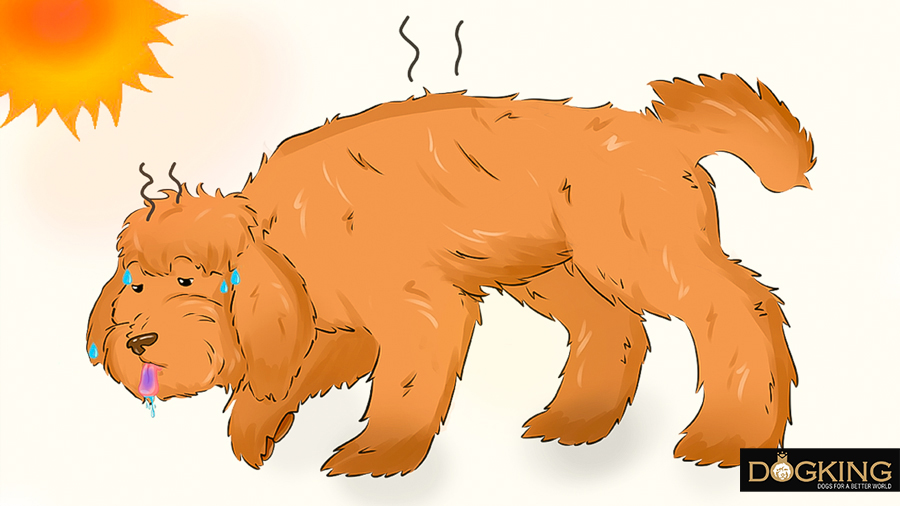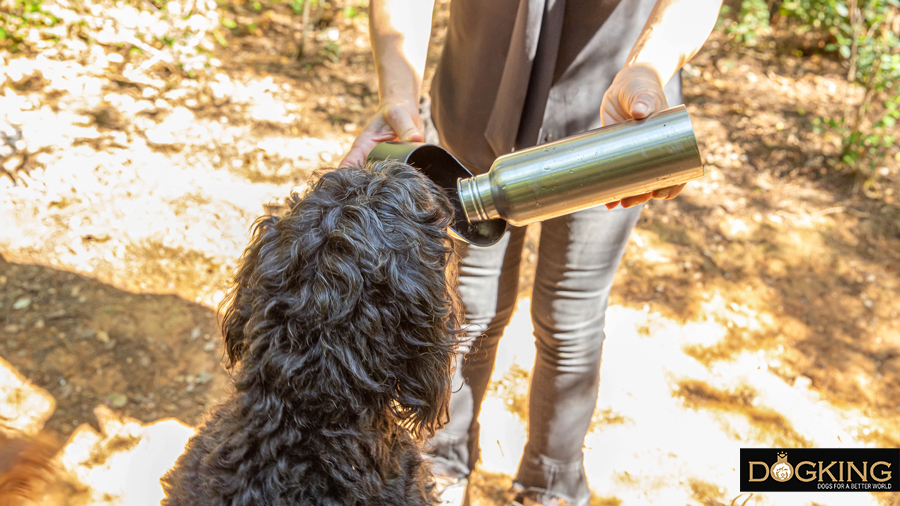Coup de chaleur : comment le prévenir, comment le détecter et que faire si votre chien souffre d'un coup de chaleur ?
L'augmentation de la température corporelle peut être très dangereuse pour votre animal

L'HYPERTHERMIE CHEZ LES CHIENS
Temps de lecture approximatif : 6 minutes
Avant de parler d'hyperthermie ou, en d'autres termes, de coup de chaleur chez les chiens, il est important de comprendre comment les chiens régulent leur température corporelle. Contrairement aux humains, les chiens n'ont pas une grande facilité à maintenir une température corporelle stable, car les seuls mécanismes dont ils disposent pour ce faire sont l'halètement et la transpiration dans les zones où ils ont moins de poils, comme les coussinets et l'abdomen.
Cependant, ces animaux sont beaucoup plus vulnérables aux coups de chaleur que nous, et il est donc essentiel de les protéger correctement contre les températures élevées. Dans le cas contraire, l'hyperthermie peut amener le corps de votre animal à atteindre une température allant jusqu'à 42°C, soit trois ou quatre degrés au-dessus de la normale. Les conséquences d'un coup de chaleur pour un chien peuvent être graves, il est donc essentiel de détecter les symptômes à temps et d'agir rapidement.

Table de matières
- Chiens présentant un risque accru d'hyperthermie
- Symptômes du coup de chaleur chez les chiens
- Que faire si mon chien souffre d'un coup de chaleur ?
- Protéger son chien contre les coups de chaleur
Chiens présentant un risque accru d'hyperthermie
Tous les chiens peuvent souffrir d'un coup de chaleur s'ils ne sont pas protégés des températures élevées. Toutefois, les chiots, les chiens âgés et les chiens de races à nez retroussé, comme les bulldogs français et les carlins, courent un plus grand risque de subir cette élévation incontrôlée de la température corporelle. L'hyperthermie est également plus susceptible de se produire chez les chiens souffrant de problèmes respiratoires ou cardiaques ou en surpoids. Et attention, si votre animal est de couleur foncée et a un pelage court, le soleil frappera plus facilement sa peau, favorisant également ces chocs thermiques.
Symptômes du coup de chaleur chez les chiens
Il est essentiel d'apprendre à reconnaître les signes d'hyperthermie chez votre chien afin d'agir rapidement, sous peine de graves lésions internes.

- Confusion, agitation ou attitude léthargique
- Salivation excessive
- Respiration sifflante et manque de souffle très prononcé
- Peau sèche et plus chaude que d'habitude
- Diarrhée ou vomissements
- Instabilité ou vertiges
- Gencives très rouges ou langue bleue
- Manque d'appétit
- Augmentation du rythme cardiaque
Que faire si mon chien souffre d'un coup de chaleur ?
Si votre animal a passé trop de temps au soleil ou a été exposé à une trop forte chaleur et qu'il présente tout ou partie des symptômes ci-dessus, il est très probable qu'il souffre d'hyperthermie. Dans ce cas, le plus important est de rester calme et de réagir rapidement pour éviter des dommages plus importants.
Le plus urgent est de faire baisser la température corporelle de votre chien, mais pas brutalement, car cela pourrait provoquer un choc encore plus important, ce qui serait très dangereux. La baisse de la chaleur doit être progressive. Tout d'abord, emmenez-le dans un endroit ombragé et aéré. Nous vous recommandons d'humidifier son corps à l'aide de lingettes humides ou de chiffons imbibés d'eau tiède, ni chaude ni froide. Insistez surtout sur le museau, le cou, les aisselles et les coussinets, afin d'aider votre chien à réguler peu à peu sa température.

Vous pouvez également le placer devant le ventilateur ou lui donner de l'air à l'aide d'un ventilateur. Faites-lui boire de l'eau, mais ne le laissez pas boire trop, laissez-le avaler peu à peu. Il peut également être utile de masser ses extrémités pour rétablir une circulation normale.
Même si vous constatez que votre chien se sent mieux après avoir appliqué ces conseils, emmenez-le tout de même chez le vétérinaire afin d'exclure toute lésion interne. Certains coups de chaleur peuvent causer des problèmes même plusieurs jours après l'apparition des symptômes, il vaut donc mieux être prudent. L'hyperthermie canine est très dangereuse, car une augmentation de la température corporelle peut causer des dommages profonds et irréversibles à des organes tels que le cerveau, les poumons, le système digestif et le cœur.
Protéger son chien contre les coups de chaleur
Maintenant que vous savez à quel point un coup de chaleur est dangereux pour un chien, voici quelques recommandations pour vous aider à protéger votre animal des températures élevées.

- Veillez à ce qu'il ait accès à de l'eau propre et fraîche. Vous pouvez la refroidir en y ajoutant un glaçon pour la rendre encore plus rafraîchissante pour votre compagnon à quatre pattes.
- Ne le promenez pas aux heures les plus chaudes de la journée, mais plutôt tôt le matin et tard le soir.
- Ne rasez pas le manteau de votre chien, car il constitue une barrière protectrice contre le soleil et la chaleur. S'il a les poils longs, emmenez-le chez le toiletteur pour qu'il se fasse raser, ce qui aura pour effet de vider les couches profondes de son pelage et de lui donner une sensation de fraîcheur.
- Ne le laissez pas enfermé dans la voiture ou dans une petite pièce mal aérée. Même si vous pensez que cela ne durera qu'un temps, un coup de chaleur peut être très dangereux et se développer rapidement.
- Rafraîchissez votre ami à fourrure ! Achetez-lui une piscine pour chien, un lit rafraîchissant ou offrez-lui une délicieuse glace maison.
- Laissez-le à l'ombre, surtout après avoir mangé, pendant la digestion.
- Ne le laissez pas faire des exercices intenses au soleil ou à des températures très élevées.
- N'utilisez pas de muselières qui ne permettent pas au chien d'haleter, car il s'agit du principal mécanisme de régulation de sa température corporelle.
Maintenant vous savez, si vous voulez profiter de l'été avec votre chien sans crainte, ne l'exposez pas au soleil ou à une chaleur extrême, aidez-le à se rafraîchir et surveillez ses symptômes afin de réagir rapidement en cas de coup de chaleur.